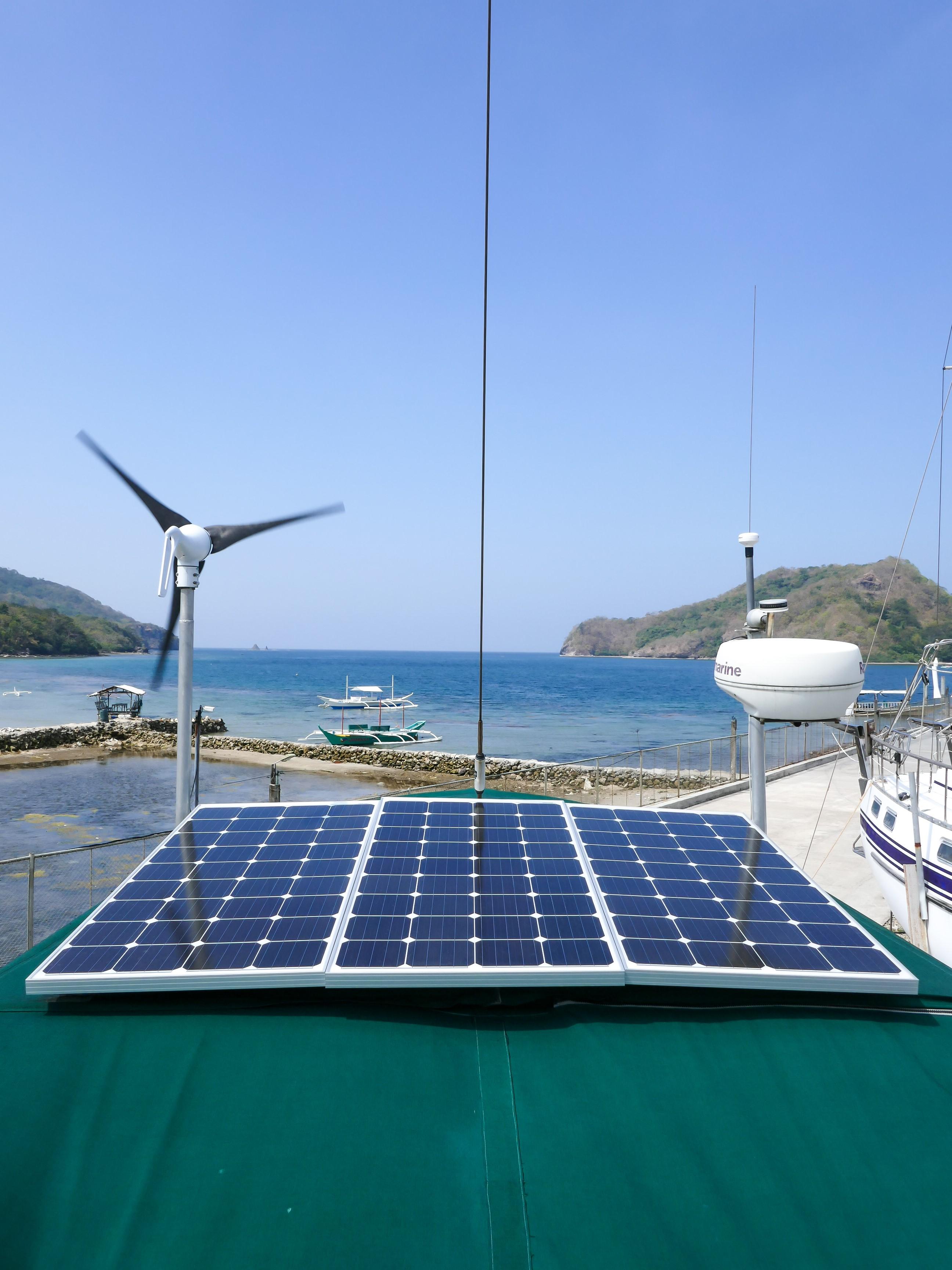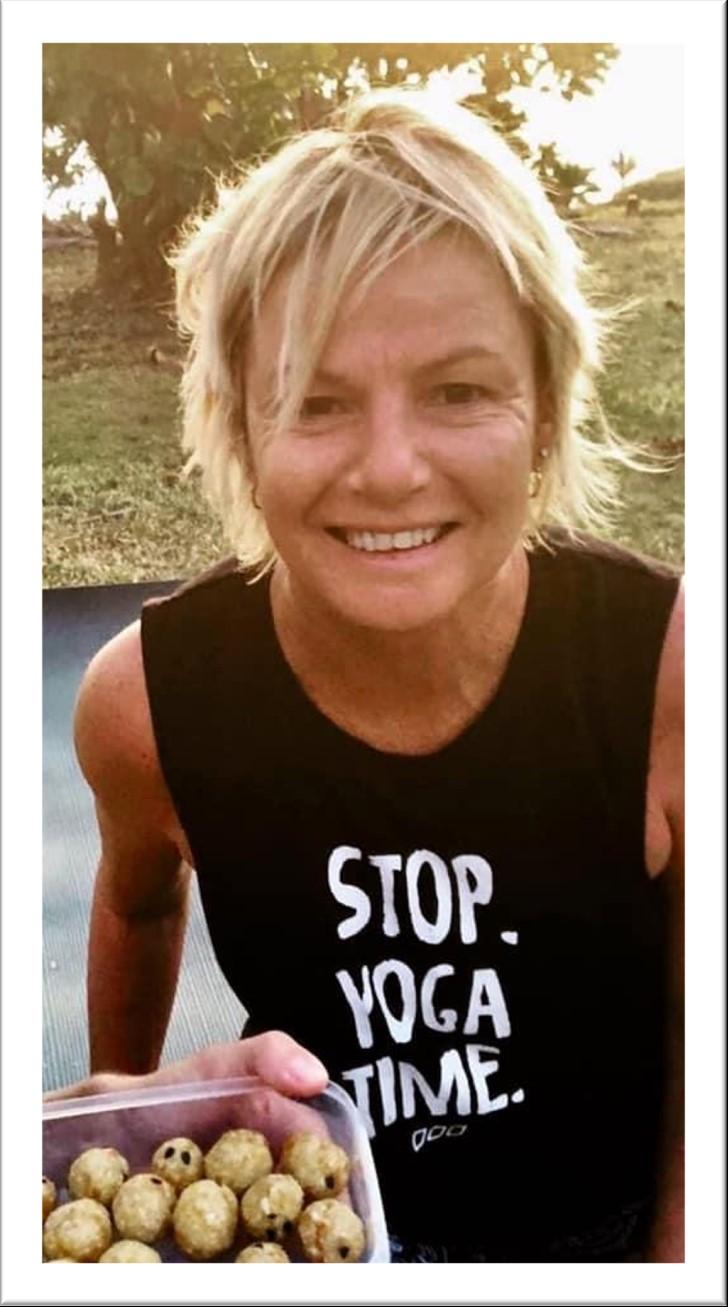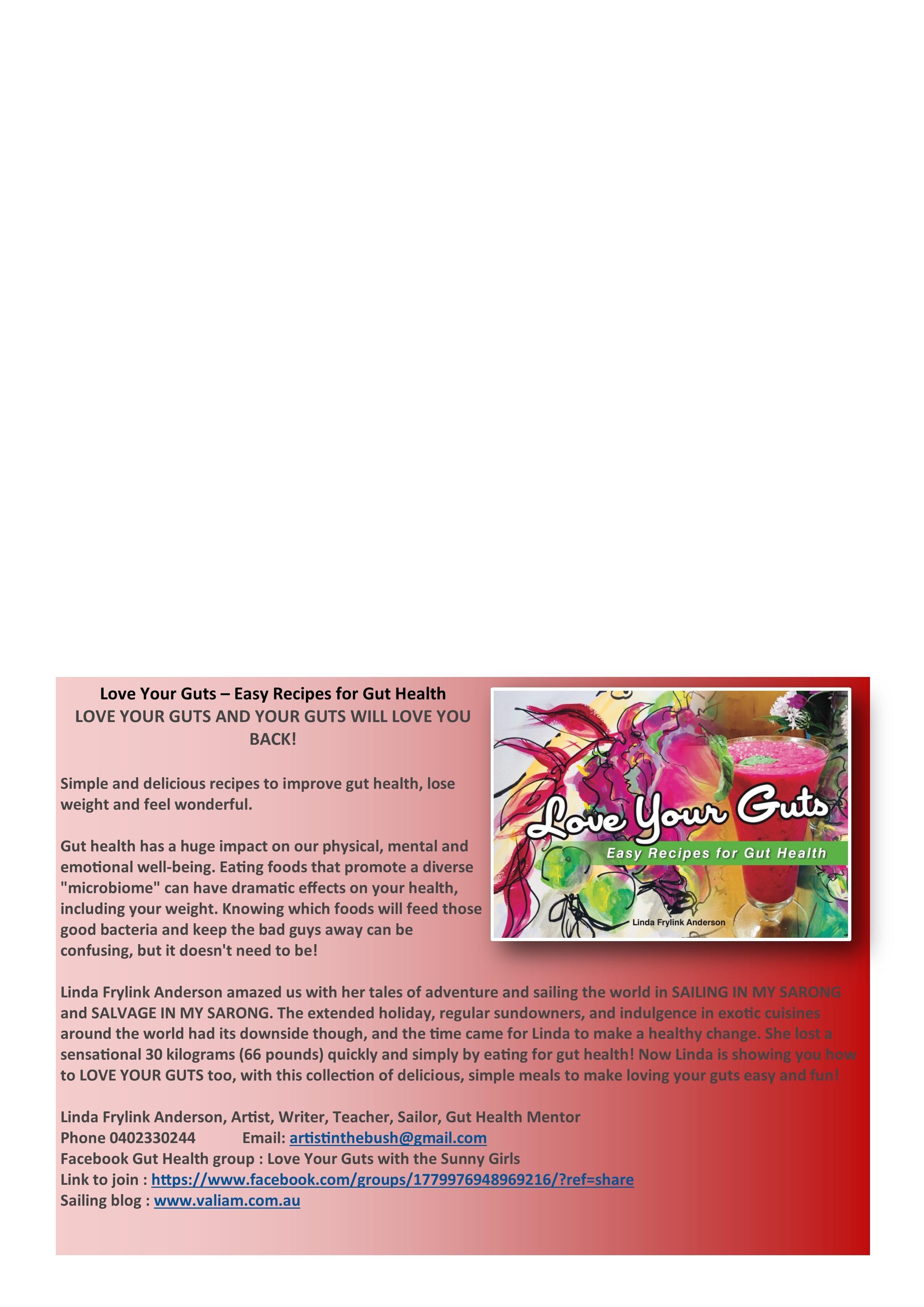
12 minute read
Sustainable Sailing
SUSTAINABLE SAILING Heather Francis

Advertisement

FOOD WASTE

For the past couple of years, I have been trying to reduce the amount of food we waste onboard Kate. I didn’t consider us particularly wasteful in the first place; a decade of sailing has taught me a lot about being mindful when it comes to our provisions. Still, there was room for improvement.
I started with little steps –vowing to use all the canned goods before buying more, making stock every couple of weeks with our leftover chicken bones, considering where our food comes from –not only fresh goods but packaged items as well. Sometimes it took willpower to buy foodstuffs we needed instead of the fancier things I wanted but knew I seldom used. Often recipes required some creative reimagining as I attempted to use random bits in the fridge rather than source new ingredients. The results were satisfying. I finally saw the bottom of our dry stores cupboard and stopped finding rotting produce hidden in the corner of the fridge. However, when I started researching how I could do more, I was stunned by the figures on global food waste.
The United Nations states that approximately one third of all food produced globally is wasted, either due to spoilage during storage and shipping or simply thrown away. That works out to be about 1.5 billion tonnes of food annually, enough food to feed the 800 million people who are suffering from starvation, twice over. The carbon footprint of that food waste is massive. When that food waste ends up in landfills, where it cannot properly breakdown, 3.3 billion tonnes of CO2 is released. If our food waste was a country, it would rank third in annual greenhouse gas emissions, just behind China and the United States. There are the issues of excess water usage, pollution, and deforestation that are all part of industrial farming. The further I dug the more depressing it seemed.
At first glance this seems like a miserable statistic, but I think it is one with an immensely powerful silver-lining. If 43% of the responsibility rests on our shoulders as the consumer then we also have the potential to change the outcome of 43% of the problem. As individuals we have the power to affect BIG global change simply by modifying a few daily food habits. If someone gave you a 43% chance of winning the lottery wouldn’t you buy a ticket?
During the current Covid-19 pandemic, as people across the globe grapple with food shortages, breaks in supply chains, labour shortages on farms and in processing plants, talking about food waste is more essential than ever. Committing to being more mindful when it comes to your consumption and food waste is an easy way to regain some control in what can seem like a very unsteady time.
The great news is, you don’t have to have super culinary skills or access to a frou frou farmer’s market or vow to give up your favourite foods, to start reducing your food waste. All it takes it is a little consideration when buying, storing, and preparing your food. As we’ve seen in recent weeks, when we all work toward a common goal the results are powerful.
USE WHAT YOU HAVE ON BOARD
Anyone who likes to cook probably enjoys planning a special meal and shopping for exotic ingredients. Unfortunately, this is not the most eco-conscious way to cook. Creating meals from items already in your pantry and fridge may not seem as glamourous but it can give you the creative kick you crave. Experimenting, learning to substitute ingredients, and exploring new cuisines can prevent food waste and make you a better cook. Many boaters take stock of provisions only when preparing for a long voyage, but regularly checking stocks is a good habit to get into. Knowing what you already have onboard will help avoid over-buying, and doing regular checks gives you a chance to rotate stock and check for any deterioration. This is especially important if you store cans in a damp bilge area where they are prone to corrosion. Bring older items forward to use and stow any new additions where they will be reached for last. And don’t forget to check fresh foodstuffs for blemishes and rot.

Taking stock.
STICK TO THE PLAN
Creating a weekly meal plan and shopping list is a great strategy to avoid food waste, not to mention stress when it comes to mealtimes. Planning meals around what you have on hand and arming yourself with a shopping list can limit impulse purchases and ensure you buy only the items that you need and will use. Buying only what is on your list when at the shops does require some practice, and if you are anything like me, remembering to take the list does too, but don’t give up.
DON’T BUY MORE THAN YOU CAN USE
One of the easiest ways to avoid food waste is to buy only the amount of food that you can use before it spoils. This can be a tough
one if you are provisioning for a long passage or time in more remote destinations. This is one of my biggest downfalls, especially when it comes to seasonal produce like mangoes or tomatoes. I like to preserve when I have a glut of fresh fruit or veg, often making a batch of quick pickles or chutney. You can also buy yourself some time by batch cooking and freezing.
EAT UGLY
Estimates state that 46% of produce never makes it from the farm to the table because of cosmetic preferences. In other words, almost half of all fruit and vegetables are wasted only because they are not pretty enough to sell. Shop at a local market, where there is usually more variety in colour, texture, and shape. If this is not a possibility, then keep your eyes open at your local grocery store for cosmetically imperfect produce labelled as “ugly.” Often sold at a lower price point you can save some food, and some money, win win.


Buying local and eating ugly. Sustainable eating means getting to know your food, it can be uncomfortable but it better for the planet in the long run.




PROPER FOOD STORAGE
There are many tricks you can use to extend the life of your fresh goods. Storing herbs and leafy greens in cups of water, using breathable beeswax food wraps, keeping onions and potatoes separate, rotating eggs, vacuum packing freezer items, and keeping a big fridge well organized are all ways to improve food storage and reduce food waste. Food storage is a popular topic, the list of resources online is endless.
USE YOUR SENSES
Best Before, Best If Sold By, Use By. These are all phrases used in the food industry, but what do they really mean? Unfortunately, there is little in the way of standards when it comes to these BEST suggestions. Sold By dates promote product turn over in stores and do not indicate when food will spoil. Use by and Best Before suggest when the flavour of the food may deteriorate but do not mean the item is no longer safe for consumption. When buying or eating food after these suggested dates trust your senses. Check cans for rust, dents and bloating, check that the pressure button on any jar top is not “popped”, and discard anything that seems

suspect. Mold, major discolouration, and strange odours are bad signs. Toss anything that is unexpectantly fizzy immediately. Meat, dairy, and fish that look or smell strange should definitely be avoided.
SHOP LOCAL VS. ORGANIC
Many people choose organic over locally grown, thinking that it is a better choice for the environment. However, that isn’t always the case. Organic does not necessarily denote pesticide and chemical free. Regulations on organic farming vary greatly from country to country. Getting an organic certification can be cost prohibitive for small farmers. It is important to consider farming practices, shipping distances, and packaging when choosing your food. Buying something organic that is from an industrial farm, wrapped in plastic, and shipped half way across the world probably has a greater environmental impact than choosing locally grown but not certified organic.
EAT SUSTAINABLY
What we choose to put on our plates has far reaching environmental consequences. Eating sustainably asks that we consider where and how our food is grown, the resources used, the environmental impact of the entire process, the conditions of the animals, and how the workers are treated and paid. It is a return to more traditional methods of food production that values the land, the animals, and the people as much as the profit. You can eat sustainably by reducing your meat consumption, choosing wild caught instead of farmed fish, eating seasonally, buying local, buying Fair Trade, growing or making your own, and eating less packaged and processed foods.
It is easy to feel overwhelmed when considering the environmental and social impacts of something as simple as the we food we eat. However, perhaps now more than ever, it is important to be mindful of what you put in your body, where your food comes from, and how it is produced. I hope these suggestions give you a tangible and easy place to begin your own journey towards reducing food waste. And remember, the small steps we take together towards reducing food waste can, and are, making a difference.
Heather Francis is from Nova Scotia, Canada and has lived and worked on boats throughout the world. Since 2008 she has been living and sailing onboard Kate, a Newport 41 sloop, with her Aussie partner, Steve. She is a writer, photographer and cook who tries to live mindfully. Follow at www.yachtkate.com or @sustainablesailing41


By Leanne Hembrow
Roasted Cauliflower and Leek Soup (Serves 4)
Original recipe credit by Yogue
I love this recipe. I was introduced to it through my yoga community during a Facebook project in 2018. You can make it thicker and use as a substitute for mash potato.
This creamy and rich tasting soup has no dairy but is full of vitamins and anti-inflammatory benefits. Make extra and freeze it for a lunch later on in the week.
Ingredients:
1 head of a small cauliflower 2 leeks 2-3 cloves of garlic 2 tbsp cold pressed extra virgin coconut oil (or ghee) or extra virgin olive oil Pinch of turmeric Fresh ground black pepper + Himalayan pink salt or Celtic sea salt 2 cups organic chicken or veggie broth Sesame Seeds Filtered water as needed.
Preheat the oven to 400 degrees F
Bake:
Line a rimmed baking tray with parchment paper. Scatter vegetables in a single layer, drizzle with oil, add some salt, pepper and that pinch of turmeric, as well as any other herbs you might like to use. Place the tray onto the middle rack of the oven and roast for 20 minutes. Check vegetables for softness and if needed roast for approx. 10 minutes longer. Remove tray from the oven, let the vegetables cool slightly.
Blend:
To make the soup, pour the veggies and chicken broth into a high-speed blender and blend until smooth in two stages, so the blender does not overfill. You can also use an immersion blender in a soup pot. Add more water if needed to liquefy the soup to a consistency you like, 1 cup should do it.
Enjoy:
Taste the soup and serve in a bowl, topped with toasted black or white sesame seeds for extra minerals and a toasty crunch.
Prep:
Gently wash, drain, and rinse the cauliflower, then break it into medium sized florets using clean hands or a knife. Discard hard bits of the white stalks, but keep the tender ones, chopping them into 1/4-inch pieces. Use the white portion of the leeks. Save the green stalk ends in a freezer bag or box for making stock in the future. Slice the leeks lengthwise first into half, then chop into half-moons. Wash leeks well in a bowl of water. Peel and slice the garlic into halves.

Yoga Health and Sail Wellness is all about learning how to reclaim the ‘Healthy Happy You’. In the process you will gain so much knowledge about great food and yoga. You will receive daily emails to your inbox with much help to keep you focused and enjoy the 30 days of stepping in the right direction to regain your smile and confidence with the body you’re in.











My Sail Wellness program is based on years of health experiences whilst sailing, with help through nutritional mentor advice - understanding common allergies and what we all know now as a problem gut. I bring you encouragement and wellness via daily mentoring. I encourage your phone calls, video chats and provide tips on food, healthy recipes, nutritional supplements advice, a 4-week meal plan, along with Yoga guidance. All included in the program. As a bonus, once subscribed to my program you also receive a range of discounts with Yoga Retreats, workshops, yoga clothing, and monthly subscribed Yoga Wellness and set fee private zoom yoga classes.



Leanne has been involved in Health and Wellness most of her adult life, she is a trained Esthetician, E-RYT 200/ *400 CYT* Yoga Teacher and wellness mentor.













